Grand Teton National Park
Wyoming
The Middle Teton
Glacier Route
September, 8, 1988
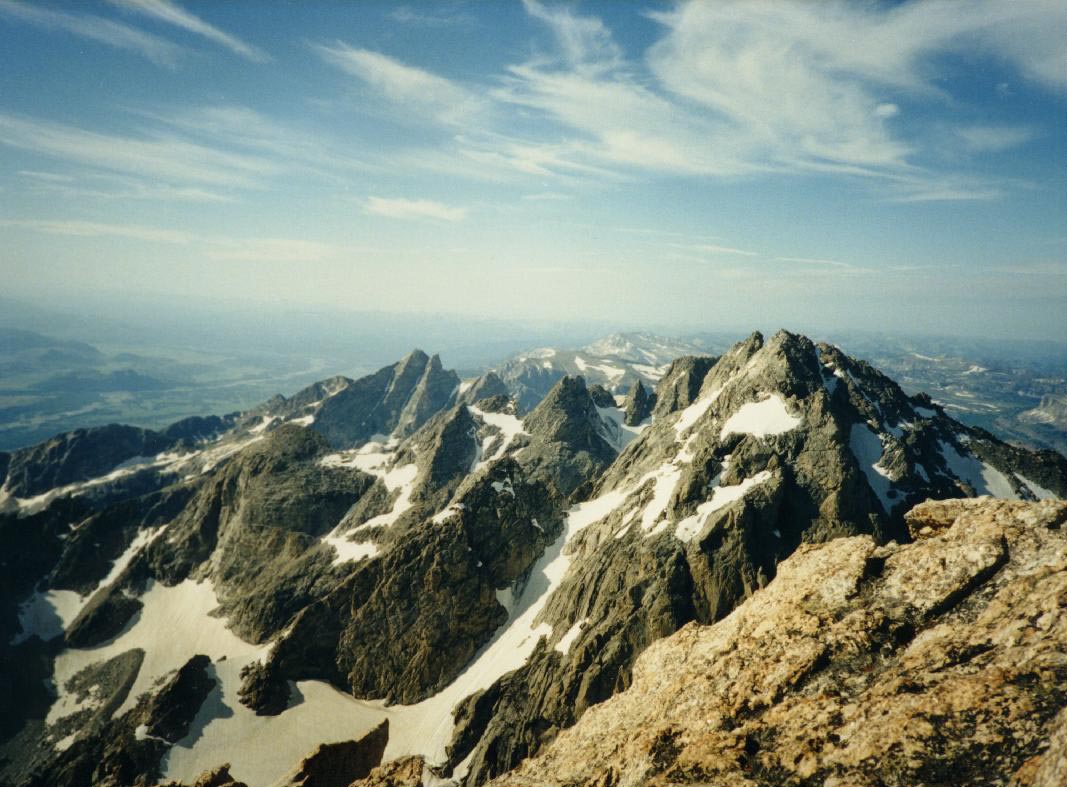 Middle
Teton in Summer (taken from the Exum Ridge on the Grand.) (Click on picture for
larger version.)
Middle
Teton in Summer (taken from the Exum Ridge on the Grand.) (Click on picture for
larger version.)
It was September of 1988. It had been about a year since my near disastrous first trip to the Tetons. At the conclusion of that epic, I had been sure that I would never take an interest in alpine climbing ever again. I had not forgotten the miserable unplanned bivi or the other discomforts and dangers of that trip, but these negative aspects had begun to fade somewhat in my mind. Since my first Teton trip, a number of other things had changed in my life as well. The biggest change was that I was now married. We were living in a cozy little basement apartment in Provo. Dorothy was attending school, and I was working on my Honors thesis and teaching English as a Second Language at Provo High School. Another thing that had changed was that Matt was no longer around. He and Sharon had moved to Columbus, where he was working on his Ph.D. in Chinese at Ohio State University. With Matt gone, and the responsibilities of marriage and work, I climbed less than I had before. I did still get to climb a little, however, and I met various other partners, mostly just by hanging out and climbing at the local crags.
I was beginning to become somewhat dissatisfied with simple cragging, however, and found myself thinking about alpine climbing again. The university library had several books by Gaston Rebuffat, including The Mont Blanc Massif, the 100 Finest Routes, and Starlight and Storm. These books described alpine climbing on snowy, icy peaks, and I began to dream of climbing an alpine ice route. On my first trip to the Tetons, I had noticed the glacier route on the Middle Teton. I had observed a Man and a teen-aged boy kicking steps up the snowy route, and had thought that it looked like a straight forward and enjoyable climb. I began to make plans for a return to the Tetons to attempt the Middle Teton Glacier. The one thing missing was a partner. I put up an ad on the bulletin board at Hansen's Mountaineering saying that I was in search of a partner for some alpine snow and ice routes in the Tetons. It wasn't too long before I got a call in response to my ad, from a guy named Brian. We decided to go cragging together up in Little Cottonwood Canyon, to take the measure of each other's abilities, and to get used to climbing together.
I met Brian up at Little Cottonwood one Saturday and we headed up to climb the Green Adjective, a classic 5.9 thin crack/friction climb. Brian led the first pitch, and I was impressed with his abilities. Protection on the first pitch was marginal, just a few tiny wireds and rp's. He didn't seem phased by the poor pro, however, and climbed the pitch smoothly and without much hesitation. He, in fact, did a better job than me, as I fell twice following the pitch (much to my embarrassment). Brian was a pleasant guy, and he seemed like a competent climber (he'd done some ice climbing in Scotland with his college club too), so I asked him if he wanted to try the Middle Teton Glacier with me. He seemed excited about it, and said yes.
We spent the next several weeks planning our trip. Dorothy was not very happy about me going climbing in the Tetons again. She was worried that I would die in the mountains, and did what she could to discourage me from going. In the end, however, she saw that the trip meant a lot to me, so she reluctantly began to support me in my goal. We had Brian over to our house for dinner, and he was a very gracious guest. Finally, a date for the trip was set, and I was able to look forward to the time when all of our preparations and planning would be put into action.
When the day finally arrived, Dorothy and I drove to Brian's apartment in Salt Lake and traded cars with him, as he was lending his red Alpha Romeo Spyder to Dorothy for her to use while we were gone on our trip. Brian and I took Dorothy's thrashed 1980 Datson B-210, loaded it with our gear, and headed for Jackson. We had a late start, and by the time we got to Jackson, it was night and pitch black. There were huge forest fires in Yellowstone that year, which had created a pall of smoke across the sky, so there were not even any stars out. After driving around for a while, we finally located a place to pull over and sleep next to our car. It was a big open field, that appeared to be a sort of collection place for abandoned cars, as we could see the dark shapes of ten or so junked vehicles littering the field. We spread out our sleeping bags and fell asleep next to the car. I was awakened later that night by the sounds of snuffling and low whining. I opened my eyes and sat up, only to find myself in the middle of a large pack of coyotes. My movement, and subsequent yelling startled them, (and Brian) and the coyotes all took off, yapping loudly. We went back to sleep, but were awakened at the crack of dawn by the sound of a pick-up truck, which pulled off of the road and parked near us. I rolled over and peered out from behind the car, a bit worried that we had been caught trespassing on private property. As I watched, several more cars and trucks began to appear, pulling up and parking near the road, about 100 yards from where we were. Before long, there were about 10 cars and trucks, and Brian and I began to wonder what was going on. Then, in the light of morning, we began to take a better look at our surroundings. We almost immediately noticed that the junked cars all around us were riddled with bullet holes, and that interspersed among the junked cars were crude targets mounted on posts, also filled with holes. Squinting in the dim morning light at the crowd that was assembling by the road, we realized that they were all carrying rifles, and a number of them seemed to be aiming at our car. We were parked in the middle of a shooting range. So far, we had stayed hidden behind our vehicle, but had we stayed hidden, no doubt my wife's Datson (which could easily be mistaken for a junked vehicle) would have been shot to pieces by this early morning gun club. We jumped up, waving our jackets to alert them that there were people here, and that the Datson was not just a new target towed here for their blasting pleasure. We threw our stuff back into the car and drove out of the way as quickly as possible. As soon as we drew even with the line of shooters, they began to open up on targets in the field, and we drove off to the sound of gunfire. Welcome to Wyoming, the Cowboy State.
After the obligatory Egg McMuffin breakfast, we headed for the ranger station to register and pick up some information on our intended route. The ranger station was almost deserted, as most of the staff had gone to Yellowstone to help with the forest fire problems. The only person there was a guy with no helpful information regarding our route. He did give us the (incorrect) advice that because it had been a very dry year, there would be no water at our campsite, and that we should therefore carry all of our water with us.
The hike up to the base of the route was uneventful. At first it was difficult because of the thick smoke which covered everything, and made breathing difficult. After a while, however, we gained enough altitude that we rose above the smoky haze and were breathing clean mountain air again. The scenery was familiar this time, but no less spectacular. The trail up to our camp was also just as strenuous as I had remembered, and I was glad that we did not have to go all the way up to the lower saddle. We made camp at the base of the Middle Teton glacier, and found, to our disgust, that there was plenty of water, and that the ranger's misinformation had caused us to unnecessarily carry several liters of water up the steep trail. We went to bed early, but were a bit concerned when later that night, it began to rain heavily. We were awakened before dawn by our alarms on our watches, but it was still raining heavily. We continued sleeping, waking up every hour or so to check for any change in the weather. It continued to rain until about eleven o-clock, when it cleared up a bit, and we were faced with a choice. We could either abandon our attempt at the climb, or we could get a late start and climb the route anyway under uncertain weather conditions. With the strenuous approach hike fresh in my mind, I was very unwilling to turn around and go back without climbing. I was also convinced that the climb would be pretty simple, and that we could do it in spite of our late start. Brian was of the same mind, so we gathered our gear, and headed up the glacier.
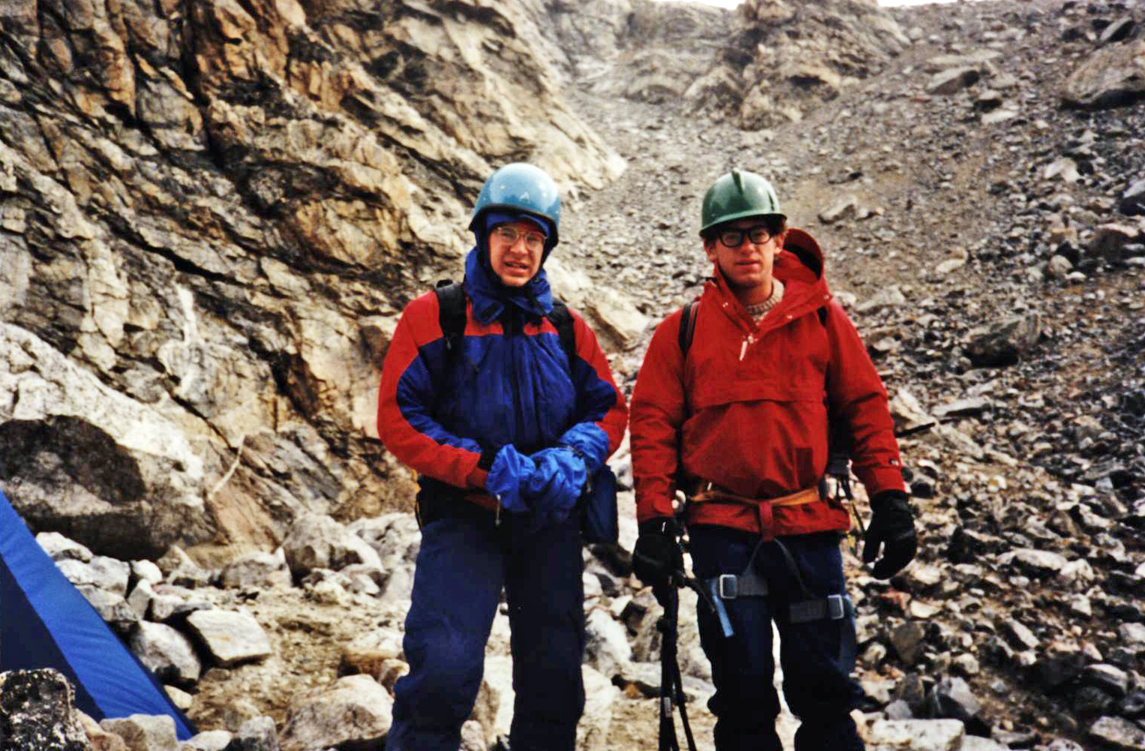 Geared up and ready to go. (Click on picture for
larger version.)
Geared up and ready to go. (Click on picture for
larger version.)
The bottom portion of the glacier was low angle, and we crossed it unroped and without much difficulty. The only tricky sections involved getting across several crevasses, which we crossed by downclimbing or lowering ourselves down into them, and then climbing up the other side. It was while climbing out of the second of these crevasses, that the rain began again, this time accompanied by lightning. We spent about 45 minutes sheltering in the crevasse until the storm eventually passed us by. When we finally got to the base of the couloir, which marked the start of the technical climbing, it was already about two o-clock. We were late and we knew it, but we were determined to have a go at it anyway. The route involved seven or 8 rope lengths of ice climbing in the couloir, and then some lower grade (up to 5.4) climbing and scrambling on rock from the top of the couloir to the summit of the Middle Teton. We had headlamps, and believed that we could cruise up the route quickly, finishing the descent in the dark if necessary. Unfortunately, once we began climbing in the couloir, it became apparent that the climbing was not going to be nearly so easy as we had expected. The couloir was composed of hard black ice (dark grey actually) that made climbing extremely difficult. Tools and crampons had to be swung or kicked very hard, often numerous times, in order to get any kind of purchase in the rock-hard ice. Our crampons had particular difficulty, and our front points were constantly skating off of the surface. This insecurity necessitated placing protection, but getting an ice screw started in this black ice was extremely difficult, and this difficulty increased as the route progressed and the angle of the couloir steepened. When possible, we stayed to the left side of the couloir, using pitons or wired stoppers as protection in the rock when it was available. The weather was capricious as well, and we were subjected to a number of short lived thunder showers during our climb.
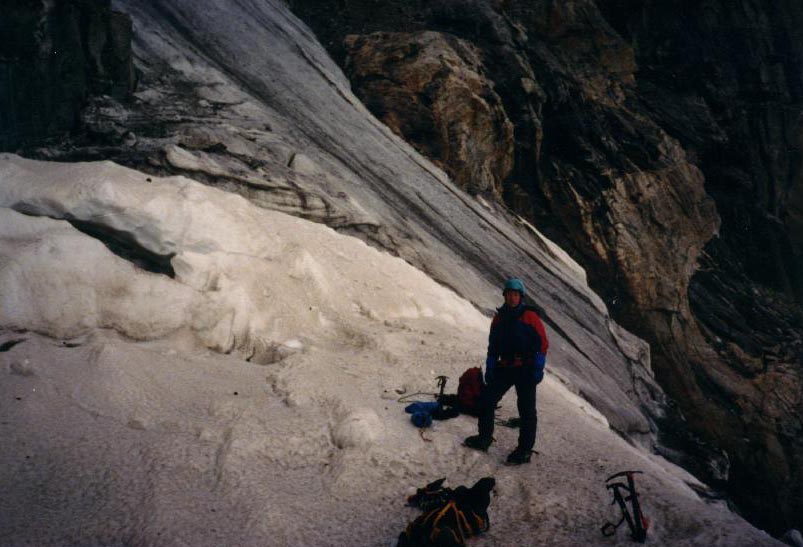 The base of the couloir. (Click on picture for
larger version.)
The base of the couloir. (Click on picture for
larger version.)
There was one particular part of the couloir that I remember extremely well. I was following Brian on the route, and when I arrived at his belay, I found him tucked into a small alcove, anchored by a tied off knifeblade piton, barely stuck into a shallow crack, and a similarly tied off ice screw, sunk only a couple of inches into shallow ice before it's teeth had hit rock. We spent some time trying in vain to improve his anchor systems, but eventually gave up, and I lead the next steep pitch, promising to put in a good ice screw at the first available opportunity. That pitch was one of the longest in my life, as I struggled to put in a screw in that hard black ice. Unfortunately, the teeth on those old Chouinard screws had begun to dull a bit from the day's climbing up the hard, gravelly ice, and I was having a very difficult time getting one to go in. I worked for a long time trying to get in an ice screw, and then gave up, deciding to try for a better protection opportunity a little higher up. I weaved to the left and right as I climbed, looking for protection options in the rock wall on the side of the couloir, but was unable to find anything. I kept moving up and up, stopping every so often to try to place a screw in the unyielding black ice, or trying to find a crack in the smooth rock walls, but I had no success. Brian kept yelling for me to put in a piece, and I kept yelling back that I was trying as hard as I could. Both of us were scared and frustrated as we knew that his anchor was not very good. After spending more than an hour on that one pitch trying to put in a screw or nut, my calves were screaming with fatigue, and I was getting pretty strung out with nervous fear. I finally decided to abandon my futile attempts at placing protection and climb while I still had any energy left. I could see a rocky outcrop above me that appeared to offer a possible spot for a belay stance, assuming I could get to it. I was about 3/4 of a rope length out at this point without a single intermediate piece of protection between me and Brian. I was making my way to this outcrop, with my left tool planted and my front points set, when my crampon points sheared out of the ice. My left tool placement popped out as well, just as I was swinging my right tool into the ice. For a fraction of a second, I had no points of contact with the ice, but was simply on my way down the couloir. Then my right tool, which I was swinging, hit the ice and stuck on the first swing (unlike the majority of my placements that day). I jerked to a stop, hanging precariously by my right arm. Aided by a huge jolt of adrenaline, I scrabbled back into position, kicking my crampon points frantically back into the black ice, and finally setting my second tool. Brian, who had been watching my progress from below, let out a howl of relief and encouragement. "WOOOOW You self arrested like a BIG DOG!!" he yelled at me. "Damn, don't fall!!" I realized that we had almost both ended up falling, sliding down the couloir only to smash into the side wall of the detached bergshrund at the base of the couloir. We would have been lucky if either of us would have survived such a fall. We surely would have been seriously injured. As I write this (October of 1999) I still believe that this was the closest I have ever come to dying in the mountains (or dying anywhere for that matter). When I finally pulled up to the rocky outcrop and negotiated a somewhat tricky mantle move to get up on it, I was shaking with fatigue, tension, and relief. I had climbed the entire rope length with no protection, and because of my futile attempts at placing screws, that single pitch had taken me more than an hour to climb. I realized that I'd had enough of this. It wasn't fun any more. I wished that we had turned around and hiked back down this morning when we had seen the bad weather. "There's no place like home" "There's no place like home." At least I was able to rig a secure anchor system at my stance.
By the time Brian arrived at my stance, it was beginning to snow heavily, and daylight was fading fast. He put on his headlamp and I watched him lead off into the deepening darkness, glad that it was him and not me that was leading this pitch, which was even steeper than the one I had just struggled up. After what seemed like a very long time, I heard his excited voice yelling. I couldn't make out what he was saying, but finally I believed that he was telling me that he had arrived at the top. I followed the pitch by the light of my headlamp, and found that, sure enough, he had found the top of the couloir. The couloir ended below a large overhanging rock, and there was a small cave formed where the overhang had blocked the falling snow and inhibited the build up of the glacier. The ceiling was formed of rock, and the front and sides were made of glacial ice. There were small gaps to the front and to one of the sides, but overall it was quite secure. When compared to the exposure of the couloir, it seemed like a fortress. It was snowing heavily, and the wind was blowing. There was no thought of abandoning our snug spot to venture back out onto the mountain face. We prepared ourselves for a bivi. We chopped out the ice of our cave, expanding it and shaping it to provide for better shelter and comfort. When this was done, we gathered our ropes, and piled them beneath us, leaning against our packs to insulate our backs from the cold wall. I had my puffy quallofill jacket, and I put it on, glad for the warmth. I also had a space blanket, although we soon realized that it was not very useful as a blanket, and ended up wrapping up Brian's feet with it when they began to get cold. That night was uncomfortable, but not terrible, as we were cold but not dangerously so. I was wearing very warm clothing (capilene underwear; carpet pile pants, synchilla cardigan, quallofill jacket, with goretex shell pants and jacket); so I survived reasonably well. Brian was a bit colder than I was, I think primarily because his clothing, while warm, was not quite as high quality as mine. His feet in particular got pretty cold during the night, and he spent a lot of time banging them together to try and keep the circulation flowing to his toes. We both managed to sleep fitfully throughout the night.
Next morning, we awoke to a winter scene. It had snowed all night, and there was about a half foot to a foot of snow everywhere. It was quite windy and still snowing, and the resulting blowing snow created white-out conditions that reduced visibility to just a few feet. From where we were, at the top of the couloir, our intended route continued on rock up the ridge to the summit of the Middle Teton. However, we could barely see the rock, and had no real idea as to where the route went. Given the lack of visibility and the snowy conditions, we decided to abandon our attempts to climb higher on the Middle Teton. We briefly considered rappelling back down the couloir, but our difficulties in finding adequate belay anchors on the way up, and the unpalatable thought of having to leave all of my ice screws behind as rappel anchors meant that we were keen to find an alternate method of descent. We explored the top of the col we were on, and found a couple of rappel slings situated on the other side of the col, above a narrow boulder- choked gully opposite the glacial couloir we had climbed. After some discussion, we decided that this gully probably led to the base of the Middle Teton, and that if we descended and then followed the base of the mountain around to the left, that we would likely reach our camp at the foot of the glacier.
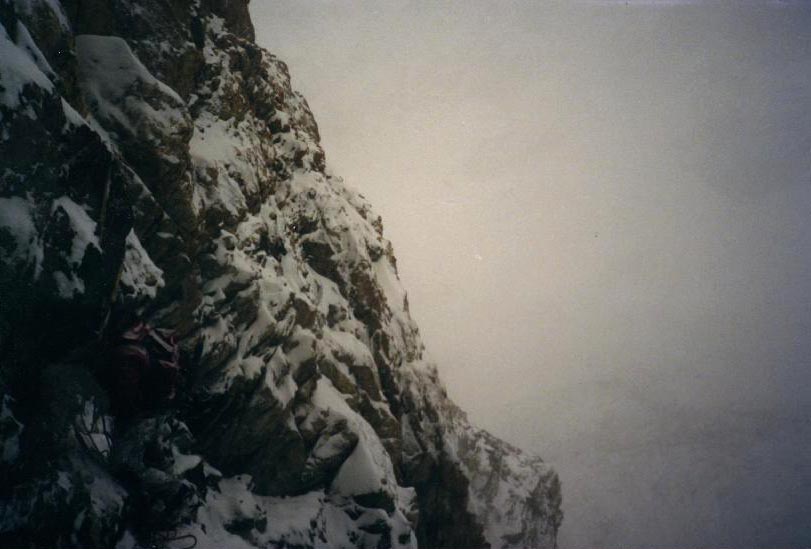 Descending in nasty conditions, Brian barely
visible in bottom left. (Click on picture for larger version.)
Descending in nasty conditions, Brian barely
visible in bottom left. (Click on picture for larger version.)
We began the arduous process of descent, alternately downclimbing and rappelling depending on the steepness and security of the rock in the gully. Conditions were not great. Visibility was almost zero, the wind was blowing, and it was still snowing. All of these things slowed us down. It was difficult to communicate with each other. You could never tell what was below you because of the poor visibility, and our ropes kept getting iced up, twisted, and tangled into complicated knots. Our tempers became a bit frayed, and at one point, Brian and I began yelling at each other over whose fault it was that the ropes had become tangled up for the millionth time. Additionally, the gully was full of loose boulders, and I think that each of us secretly suspected the other one of purposefully dislodging rocks and aiming them at whichever of us happened to be lower down.
About half way down the gully we came to a short, steep section which was not possible to downclimb safely. Brian lowered me down the section, which was about 20 feet or so, and I waited for him below as he slung the rope around a large, man-sized horn of rock and began to lower himself down, using the horn as a rappel anchor. He kicked back off of the horn to begin his rappel, when the entire horn came loose and he fell. I watched him fall, and watched the huge rock horn fall on top of him. Overall, he fell probably between 15 and 20 feet, landing right on his head. I thought I had just witnessed Brian's death. I stood there, in shock, for a few seconds looking at Brian's body lying crumpled in the rocky gully across from me. Suddenly, Brian began screaming "FUCK! FUCK! FUCK! FUUUCK!!!". Well, he was alive at least, but who knew for how long. I was sure he was seriously injured, as I had seen him take a long fall, and had seen the rock horn land on top of him. As I scrambled over to where he lay, he began to yell again, "BODY! BODY BE O.K.! BODY BE O.K.! BE O.K. BODY!" he continued to yell this until I reached his side. When I got to him, and his eyes focused on me, he looked at me and began yelling at me "WHERE'S MY HELMET!?!" His helmet, a construction helmet without an adequate chin strap, had fallen off of his head after he had hit the ground and rolled down the gully. I told him that I didn't know where it was, but that we would find it. “IS MY GORE-TEX RIPPED!?!” he demanded. I wasn’t sure what to make of this, but at least he wasn’t screaming in pain. Brian started to calm down a bit, and the two of us began to assess his injuries. I saw no blood, and he couldn't feel any pain in his limbs or torso. He could wiggle his toes and fingers, and had feeling in his extremities. He did complain about some pain in his shoulders and head, and we were both worried about possible injury to his neck. He began slowly exploring his ability to move, and after probing his neck for a while, he began to gently move his head, looking for pain or other sign of injury. Amazingly, he appeared relatively unscathed, and after a while, he sat up and was able to move around a bit. I located his helmet further down the gully, and climbed down and retrieved it for him. When I returned a few minutes later, Brian was sitting up, carefully coiling the rope. The helmet was dented and damaged from the fall, but Brian's head had been preserved. As well as I could ascertain, the steep angle of the gully had caused him to roll when he hit the ground, spreading the impact force out, rather than simply snapping his neck when he hit the ground. The big rock horn that I had thought I had seen crush him must have impacted directly behind him, and bounced over him rather than smashing him. It was unbelievable. Minutes before, I was sure Brian was dead or dying, and now we were preparing to continue our descent down the gully. He did have a bad head ache and a stiff neck and shoulder, but that appeared to be the extent of his injuries. He dug into the first aid kit for some Tylenol, and we were on our way down again. The remaining descent was mostly downclimbing, with only one short section that required a rope (this time I lowered him off). Brian was in extremely good spirits, and kept saying things like "I feel really good! This is a great trip! We're doing great!" and other optimistic exclamations. While we were stopped for a rest, I uncovered the source of his enthusiasm when I saw him pull out some more medication from my first aid kit to further alleviate his head ache. What he thought was simple Tylenol was in fact Tylenol 3 with codeine, and he had been consuming these codeine tablets for his headache. It was no wonder he was feeling great. I told him of his mistake, and got him to eat and drink a little bit. I was worried a little about him because I knew that codeine could possibly complicate a head injury, and I still wasn't convinced that he was really uninjured from his recent fall. He seemed to be showing no alarming symptoms, however, so we continued downward.
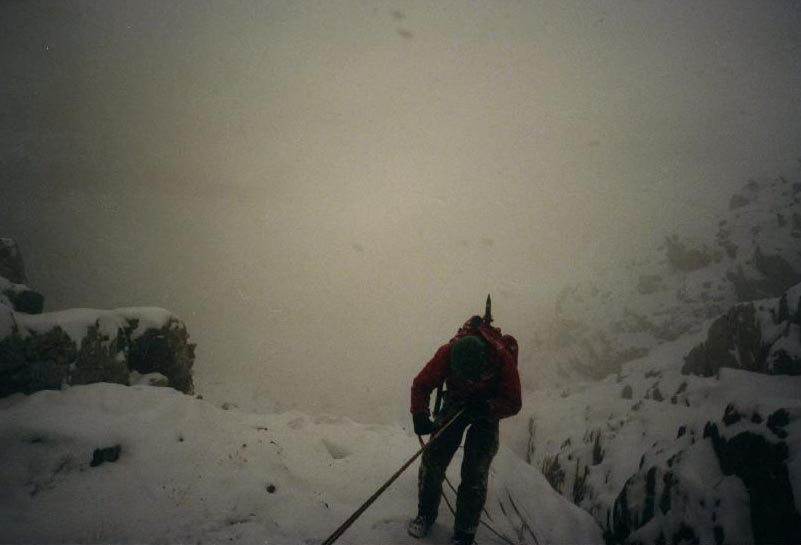 Brian rappelling before his fall. (Click on picture
for larger version.)
Brian rappelling before his fall. (Click on picture
for larger version.)
We finally reached the bottom of the gully, and began to work our way around and to the left, following the base of the mountain back toward what we hoped would be our camp. The going was not easy. There was no trail, just interminable boulder fields and small patches of glacier. The rocks were slick and snow covered, and we were wearing clunky plastic boots, which made the going even more awkward. After several hours of grueling boulder hopping, we finally came into sight of the trail. We had come out somewhat lower than our camp site, and would have to hike up hill to get back to our tent, but at least we knew where we were. When we finally got back to our camp, our pyramid tent (like everything else) was covered with about a foot and a half of snow. Inside our tent we found a hand written note from a ranger (no doubt the same one who told us of the supposed water shortage) telling us that this area was closed due to extreme fire danger, and that we were to come down at once. Looking around at the deep snow, we had a good laugh, thinking about how "dangerous" the fire conditions looked. Although I was pretty exhausted from our exertions, I knew that my wife would be worried about me, so we rested only a few hours at the camp. We broke camp at dawn, then headed back down the trail. We were down at the car before nine in the morning.
Dorothy had indeed been very worried, and was greatly relieved to get my
phone call telling her that I was all right. I was glad that she hadn't decided
to come up and look for me this time. Brian and I were exhausted, but happy to
be headed back home. Both of us felt that we had been unusually lucky to have
escaped from this climb without injury. I had to do a lot of explaining to
Dorothy about why I was late coming home again. She was extremely unhappy that
I had frightened her again, and was starting to really dislike the fact that I
climbed. It took us quite some time to work through this, but in the end she
was willing to live with my strange alpine climbing hobby. I ended up going
back to the Tetons yet again. My next visit to the Tetons, I would have no
greater success with reaching the summit than on my first 2 trips, but at least
I would return home on time.